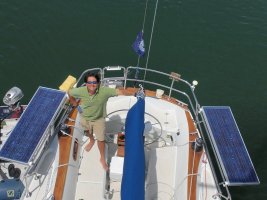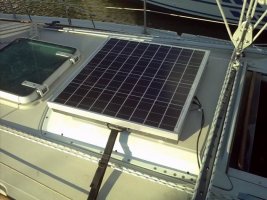Ok - more questions:
Based on the feedback, energy budget I have started and desired panel size, I am going to proceed with a panel that produces between 2.5 and 3.5 amps (40 to 60 watt). IF, these are going to be wired to the common point on the 1/2/Both switch, and the two banks have different amp hr capacities and amount of charge / drain, which bank is the charge controller monitoring and charging; or is the charge distrubted equally until both banks are charged? Is there a chance of undercharing the larger bank while the smaller bank appears to be full?
A solar panel of that size should ideally be routed directly to the house bank unless you are using your starting bank a lot more than normal, then a device like an Echo Charger can send a small charge over to the start bank to keep it topped up. Even without a solar panel an Echo Charger is a tremendous device.
How did you size this? A 2.5 to 3.5A panel can be okay depending upon the size of the bank and depending upon which charge controller you use. Ideally you want the alternator to bring the bank back to 80-85% state of charge and then let the solar panel do the rest, when you're not there during the week. The faster you can bring the bank from 80% to 100% the less sulfation you will have. So if we look at a bank of 300 Ah's you can see that the last 20% is 60 Ah's. However you need to take charge inefficiencies into account too so you'll really need to put back in about 70Ah's to get back to 100% state of charge.
For sailboats the panels are usually left flat when your not there so that you can capture "most" of the sun. In a land based installation the panels are fixed and can be angled at the sun, not so on a boat, so it is very often a compromise. If you are at a dock you can rig the panels and aim them more appropriately but not on a mooring.
Because of this you can figure on about 4-4.5 hours of full output per day on average. Some folks use 5 hours per day but here in the Northeast I found that to be a little to generous.. Some days it will be more some less.
So, a 300 Ah bank @ 20% down = 60 Ah's returned + charge inefficiency = 70 Ah's total need for "full"
A 2.5A output X 4.5 hours = 12.5 Ah's/Day returned to the bank. If you have phantom loads subtract those and that is your "net". Next divide 70 Ah's X 12.5 and it will take approximately 5.6 days to go from 80% SOC to full on a 300 Ah bank.
If the controller is wired direct to the larger bank; then the back up battery is just that - backup, and charged only off of the alternator when under power?
And this should be more than enough. If you are already starting off the house bank then your "back up" is not seeing any use so charging when running the motor should be more than sufficient. Even if you do start off this battery, then switch to the house bank, you're still only using slightly less than 1 Ah to start the motor.. They do make charge controllers that can handle two banks but with a panel that small I would not advise one and would suggest running the panel output direct to the house bank and put the charge where it needs it most.
My preference is for the controller to be able to charge 1 or both banks through the switch if possible. Reason being I can focus the solar charge to the bank that is in need.
The bank in need will almost always be the house bank, unless it failed, and you needed to use the "back up" for house loads. In a situation like that simply pull the neg lead off the house bank and switch the battery switch to BOTH and your "back up" can now be charged via the solar panel. Alternatively add an Echo Charger between the house and "back up" banks.
Any recommendations on manufacturer of 40-60 watt, polycrystalline (good output relative to panel size and weight)? Seem to be leaning to 45w from UL Solar (seemd sufficient).
I have not used a UL Solar panel and in that size range I generally install Sun Wize. Many of the more reputable manufacturers such as Kyocera, Solar World (used to be Siemans/Shell Solar) etc. have moved away from the small stuff leaving a niche for smaller companies to fill. Kyocera still makes a few but they are hard to find. Their 20W panel, for example, runs about $184.00 and their warranty covers the marine market.. They may be just fine and the price certainly looks good but do check with them about a marine market place warranty.
Please be careful with "cheap" shunting controllers. These devices begin switching on/off once the bank hits absorption voltage and can really cut your time to FULL by days, not minutes. The only controller I would use on the UL Solar web site starts at the Morningstar PS-15 which is a PWM controller with float and GEL, AGM and Wet setting. It's a decent PWM controller.
In the case of some of the Sunforce controllers, often sold at West Marine, they switch OFF at 14.2 volts and they do not switch back on again until 13.0V. This may be fine for off grid where you often have a load that sucks the bank back to 13.0V very quickly, but, with a boat on a mooring, with no loads, it can take a healthy bank a LONG time to drop the surface charge back to 13.0V. I have some customers banks of AGM & deep cycle wet cells that will hang out at over 13.0V for over an hour. That is an hour of lost charging time waiting for a cheap shunting controller to switch back on and provide maybe 60 seconds of charging before raising the bank to 14.2V and then shutting off again. Sometimes these controllers will never restore the bank to full.
Below is a video of one of the "better quality" shunting controllers, a Flex Charge PV-7. It goes OFF at 14.2v and comes back on at about 13.6v. This is showing the "current" but you can see it turn on and off. I applied a load of 0.1A just so it would go to -0.1A when OFF for the video. When you get close to full your OFF time can be as much as 10-20+ times longer than your on time with some cheap controllers.
In this case the "ON" time is about 5-6 seconds and the OFF time close to a minute to get the bank back down to 13.6v before it can turn back on again. This bank still had 20 Ah's to go and it would take 5-7+ days for this bank to eventually get "full" from an 80-85% state of charge with 5-6 seconds on and 60 seconds off, remove the 0.1A load and it would likely make this even longer..
| Cheap Shunting Controller - YouTube |
<object style="width: 425px;" height="350">
<embed src="http://www.youtube.com/v/UUaQ2FiEh2Y" type="application/x-shockwave-flash" wmode="transparent" height="350" width="425"></object> |
<tbody>
</tbody>
Contrast that Flex Charge controller, or a Sunforce, with a quality PWM or MPPT like the Genasun's and the difference in the last 15% of charge, and the time it takes, can be quite dramatic.
I just replaced both a Sunforce and a Flex Charge shunting controller in the last month with Genasun MPPT controllers. On one boat "FULL" was cut from averaging 7-8 days to about 2 days and on the other boat "FULL" was cut from roughly 5-6 days to about 1.5 days. Same boat, panels, wiring, batteries, just a much better quality controller that does not turn ON/OFF like a cheap shunter will. A LOT of the controllers you buy from "discount" solar houses are "shunters"...
If you stick with Morningstar PWM, starting at the Pro-Star series, Blue Sky, Genasun and a couple other reputable controller manufacturers, you'll be doing well. The eBay stuff is very often a scam so be careful.
I have replaced a number of eBay so called MPPT controllers that werenot MPPT at all but rather simple shunting controllers. MPPT controllers do not shut off for long periods of time.
The Genasun MPPT's are a very good value for smaller for panels. Under 150W, that is pretty much all I am installing these days.
Please be careful with "cheap" controllers as you often get what you pay for. Again can't comment on the UL Solar panels but the parent company is in the US so that's at least a start, of course they've only been around 3 years...
I generally buy from Northern Arizona Wind-Sun, Wholesale Solar, eMarine and a few others. I pay a little more but I know the quality is good and they hold up in the marine environment.
I would specifically ask UL Solar what the warranty is in a marine application.
P.S. The biggest performance killer in marine solar is SHADING! You need to keep the panel OUT OF as much shade as you can. Under the boom seems ok, convenience wise, but your charging performance will get killed. I moved one customers 40W panel from under his boom, just in front of the dodger, to his stern push pit and he went from never getting his bank to full to getting back to full in about three days. Same panel, controller and boat just eliminated about 90% of his shading issues.
 . Currently I am using a manually attached trickle charger to top off the batteries and keep them maintained, but obviously not the long term solution.
. Currently I am using a manually attached trickle charger to top off the batteries and keep them maintained, but obviously not the long term solution. 



